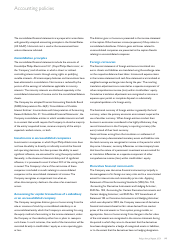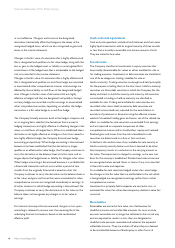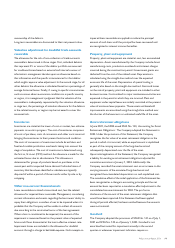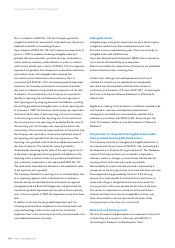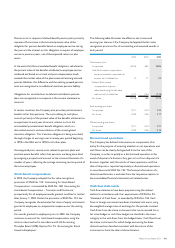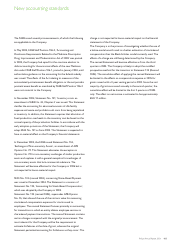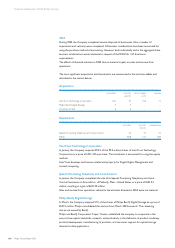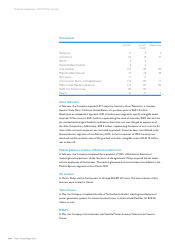Philips 2004 Annual Report Download - page 101
Download and view the complete annual report
Please find page 101 of the 2004 Philips annual report below. You can navigate through the pages in the report by either clicking on the pages listed below, or by using the keyword search tool below to find specific information within the annual report.Prior to adoption of SFAS No. 142, the Company applied the
straight-line method for amortization of goodwill over the period
expected to benefit, not exceeding 20 years.
Upon adoption of SFAS No. 142, the Company was required as of
January 1, 2002 to evaluate its existing intangible assets and
goodwill that were acquired in purchase business combinations,
and to make any necessary reclassifications in order to conform
with the new classification criteria in SFAS No. 141 for recognition
separate from goodwill. The Company re-assessed the useful lives
and residual values of all intangible assets acquired. No
amortization period adjustments were necessary. Also, in
connection with SFAS No. 142’s transitional goodwill impairment
evaluation, the Company performed an assessment of whether
there was an indication that goodwill was impaired as of the date
of adoption. To accomplish this, the Company was required to
identify its reporting units and determine the carrying value of
each reporting unit by assigning the assets and liabilities, including
the existing goodwill and intangible assets, to those reporting units
as of January 1, 2002. Furthermore, the Company was required to
determine the fair value of each reporting unit and to compare it
to the carrying amount of the reporting unit. To the extent that
the carrying amount of a reporting unit exceeded the fair value of
the reporting unit, the Company was required to perform the
second step of the transitional impairment test. In the second step,
the Company was required to compare the implied fair value of
the reporting unit’s goodwill with the carrying amount of the
reporting unit’s goodwill, both of which would be measured as of
the date of adoption. The implied fair value of goodwill is
determined by allocating the fair value of the reporting unit to all
of the assets (recognized and unrecognized) and liabilities of the
reporting unit in a manner similar to a purchase price allocation
upon a business combination in accordance with SFAS No. 141.
The residual fair value after this allocation is the implied fair value
of the reporting unit’s goodwill.
The Company identified its reporting units as one level below that
of an operating segment, which is the level that constitutes a
business and reports discrete financial information to segment
management and the Board of Management, and performed the
transitional goodwill impairment test for each of those reporting
units in the first quarter of 2002. No impairment arose from these
tests.
In addition to the transitional goodwill impairment test, the
Company performed and completed its annual impairment tests,
using methodology similar to that used for the transitional
impairment test, in the second quarter of all years presented in the
consolidated statements of income.
Intangible assets
Intangible assets arising from acquisitions are amortized using the
straight-line method over their estimated economic lives.
Economic lives are evaluated every year. There are currently no
intangible assets with indefinite lives.
In-process Research and Development (R&D) with no alternative
use is written off immediately upon acquisition.
Patents and trademarks acquired from third parties are capitalized
and amortized over their remaining lives.
Certain costs relating to the development and purchase of
software for internal use are capitalized and subsequently
amortized over the estimated useful life of the software in
conformity with Statement of Position (SOP) 98-1, ‘Accounting for
the Costs of Computer Software Developed or Obtained for
Internal Use’.
Eligible costs relating to the production of software intended to be
sold, leased or otherwise marketed are capitalized and
subsequently amortized over the estimated useful life of the
software in accordance with SFAS No. 86, ‘Accounting for the
Costs of Computer Software to be Sold, Leased or Otherwise
Marketed’.
Impairment or disposal of intangible assets other
than goodwill and tangible fixed assets
The Company accounts for intangible and tangible fixed assets in
accordance with the provisions of SFAS No. 144, ‘Accounting for
the Impairment or Disposal of Long-Lived Assets’. This Statement
requires that long-lived assets are reviewed for impairment
whenever events or changes in circumstances indicate that the
carrying amount of an asset may not be recoverable.
Recoverability of assets to be held and used is measured by a
comparison of the carrying amount of an asset with future net cash
flows expected to be generated by the asset. If the carrying
amount of an asset exceeds its estimated future cash flows, an
impairment charge is recognized in the amount by which the
carrying amount of the asset exceeds the fair value of the asset.
The review for impairment is carried out at the level where
discrete cash flows occur that are independent of other cash
flows. Assets held for sale are reported at the lower of the
carrying amount or fair value, less costs to sell.
Research and development
All costs of research and development are expensed in the period
in which they are incurred, in conformity with SFAS No. 2,
‘Accounting for Research and Development Costs’.
100 Philips Annual Report 2004
Financial statements of the Philips Group









